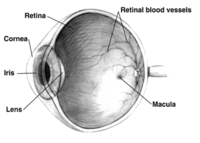
Photo from wikipedia
Purpose To study the clinical features and long-term clinical outcomes in polypoidal choroidal vasculopathy (PCV) in eyes with different sub-foveal choroidal thickness (SFCT). Methods In this retrospective, observational comparative study,… Click to show full abstract
Purpose To study the clinical features and long-term clinical outcomes in polypoidal choroidal vasculopathy (PCV) in eyes with different sub-foveal choroidal thickness (SFCT). Methods In this retrospective, observational comparative study, treatment-naïve eyes diagnosed with PCV using the ‘EVEREST-2’ study criteria were included. The eyes were divided into three groups of thin, medium and thick choroids, based on the SFCT data of total study eyes. Demographic, clinical, imaging features and treatment outcomes between the 3 groups were compared. Results Sixty-three eyes in 63 patients were included. Right eye was involved in 39 (61%) cases and left eye in 24 (39%) cases. Mean age was 68.3 ± 6.82 years (range 54–85 years). Mean SFCT was 274 µm (median = 269 µm), and one standard deviation was 79.2 µm. Totally, 11, 43 and 9 eyes were included in the thin, medium and thick choroid groups, respectively. The mean SFCT was 161 ± 24.1 µm, 275 ± 39.6 µm and 412 ± 26.2 µm in the thin, medium and thick choroid groups, respectively. There was no statistically significant difference in the clinical and imaging features and treatment outcomes between eyes with thin, medium and thick SFCT. Conclusion Eyes with PCV can have a choroid of varying thicknesses. Clinical, imaging and treatment responses were similar between the three sub-foveal choroidal thickness groups in this study. In future, more studies are required to evaluate the role of the choroidal thickness and its relationship to treatment in PCV.
Journal Title: International Ophthalmology
Year Published: 2020
Link to full text (if available)
Share on Social Media: Sign Up to like & get
recommendations!